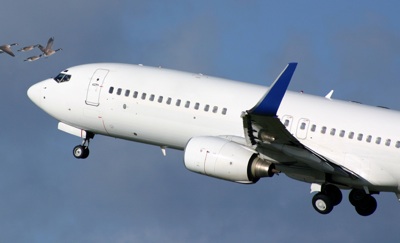
News
Products
Controlling Pest Geese at Airports
 Controlling pest geese at airports has become quite a topic in the news today. On January 15, 2009 US Airways flight 1549 ended up in the Hudson River after losing both of its engines to bird strikes.
Controlling pest geese at airports has become quite a topic in the news today. On January 15, 2009 US Airways flight 1549 ended up in the Hudson River after losing both of its engines to bird strikes.
March 25, 2009 By Fran Prisco

|
Controlling pest geese at airports has become quite a topic in the news today. On January 15, 2009 US Airways flight 1549 ended up in the Hudson River after losing both of its engines to bird strikes. On its initial climb out of LaGuardia Airport, the plane flew through a flock of Canada Geese, which resulted in a complete loss of thrust from both engines. Although it is unusual for a plane to lose both engines to bird strikes, The FAA says that in 2008 there where almost 7,000 reported incidents of bird strikes with planes, and that’s only a quarter of the actual ones that are happening each day.
For obvious reasons most wide-open grassy areas surround airports, which make perfect places for pest birds such as Canada Geese to make their homes. These areas are usually fenced in and off limits to the public, so the geese have found a nice home where they are virtually undisturbed. There is plenty of grass to graze on and often a water source as well. Having a growing population of geese residing just a few miles off the departure end of a runway is a big concern for any air traffic control manager. Most airports try to chase the birds with sounds such as cannons and banging or screeching shells which birds can become accustomed to. They spend countless hours chasing the birds with these devices and yet the geese keep coming back. So how can airports rid the surrounding areas of pest geese more effectively?
Keeping the Geese Away:
There are several methods to keep pest geese away from the surrounding areas of airports. It is important to realize that more than one method of goose control may be required to effectively get rid of the birds. The key to getting rid of pest geese is to eliminate their food source and make it very uncomfortable for them to reside in an area. To eliminate the food source you can use a goose repellent that is a mixture of Methyl anthranilate; a grape extract that naturally occurs in concord grapes. The repellent is sprayed on the lawn that the geese are feeding on; it grows into the blades of grass and “flavors” them so that the geese do not like the taste. They will move on to an area that has a more palatable food source. There are also sound devices that can be used in conjunction with the liquid goose repellent that play goose distress calls along with predator calls to scare the geese. These devices will cover well over an acre of land with the sound. Used together, the geese will find the area uninhabitable and leave.
Another issue with the pest geese and airports is that they will often fly into the flight paths of the planes. A new product on the market addresses this issue. Bird fogging units are now used to control pest birds where they fly. The units distribute methyl anthranilate in a fine “mist” that the birds fly through. The “mist” irritates the birds’ trigeminal nerve and mucous membranes through entry in the eyes, nose or mouth. They do not like the sensation caused by the methyl anthranilate and will leave the area or choose another flight path. This product is being used successfully in open areas to keep pest birds like the Canada Geese away. Once installed the spray units are easily programmed from a central control unit.
Airports may need to use one or all of the methods discussed to keep planes from sharing the skies with Canada Geese. An integrated approach of using cannons, bird repellents and sound systems may be necessary to keep the pest geese away. The money invested in an effective goose control program will help to protect the areas around our airports from the potential dangers of pest geese. It may also save lives!
For more information on goose control at airports contact Bird-B-Gone, Inc. at 1-800-392-6915 or visit www.birdbgone.com .